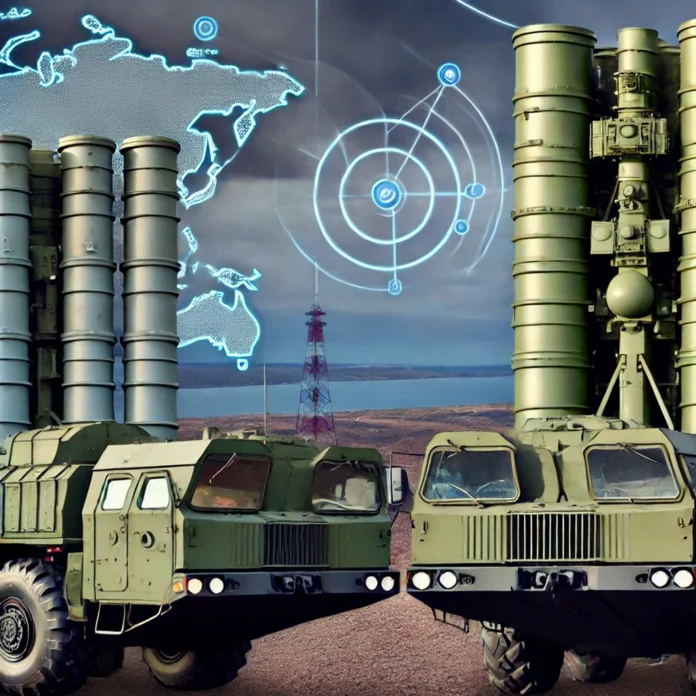S-400 “Triumf” Missile Defense System
What the S-400 Can Hunt:
- Aircraft (Fighter Jets, Bombers, etc.):
- The S-400 is optimized for engaging various types of aircraft, including modern fighters like the F-15, F-16, F-18, and even stealthier aircraft like the F-35 and F-22. Its advanced radar systems allow it to detect and target these aircraft at long ranges (up to 400 km) and varying altitudes.
- Unmanned Aerial Vehicles (UAVs) / Drones:
- The S-400 can engage drones and UAVs, including both large, high-altitude reconnaissance drones (like the Global Hawk) and smaller tactical drones used for surveillance or combat roles. However, targeting smaller and low-flying drones could be challenging depending on the drone’s radar signature and speed.
- Cruise Missiles:
- The S-400 is capable of intercepting cruise missiles such as the Tomahawk or other low-flying, radar-evading missiles. Its multi-layered defense with various missile types allows it to target incoming cruise missiles before they hit their targets.
- Short-Range and Medium-Range Ballistic Missiles:
- The S-400 is designed to intercept short- to medium-range ballistic missiles. It can track and engage incoming missiles within a certain range and altitude, though its ability to intercept higher-speed and long-range missiles (such as intercontinental ballistic missiles, ICBMs) is limited.
- Stealth Aircraft:
- The S-400’s radars are designed to detect and track stealth aircraft, which have low radar cross-sections. While it claims anti-stealth capabilities, detecting and effectively targeting advanced stealth jets like the F-35 or B-2 Spirit depends on various factors such as distance, angle of approach, and environmental conditions.
What the S-400 Struggles or Cannot Hunt:
- Intercontinental Ballistic Missiles (ICBMs):
- The S-400 has limited capability against ICBMs. These missiles travel at extremely high speeds and at very high altitudes, making them difficult for the S-400 to intercept. The S-500, not the S-400, is designed to deal with such threats.
- Hyper-Maneuverable or Hypersonic Missiles:
- While the S-400 can intercept some ballistic missiles, it struggles against more advanced, hypersonic missiles that can travel at speeds greater than Mach 5 and can maneuver unpredictably. These types of missiles represent a challenge for most existing air defense systems.
- Very Small, Low-Altitude Targets:
- Extremely small and low-flying objects, such as micro-drones or cruise missiles flying at tree-top level, can evade detection due to their low radar signatures and the complexity of distinguishing them from ground clutter.
- Swarm Attacks:
- The S-400 can engage multiple targets simultaneously, but it could be overwhelmed by a large number of incoming threats, such as a swarm of drones or a coordinated missile barrage. The system’s capacity to handle large-scale saturation attacks is a potential vulnerability.

S-500 “Prometey” Missile Defense System
What the S-500 Can Hunt:
- Intercontinental Ballistic Missiles (ICBMs):
- The S-500 is designed to intercept ICBMs during their mid-course and terminal phases. This makes it one of the few systems capable of engaging nuclear-capable missiles traveling at extremely high speeds and altitudes.
- Hypersonic Missiles:
- Unlike the S-400, the S-500 is explicitly engineered to intercept hypersonic missiles. These missiles, which can travel faster than Mach 5 and have the ability to maneuver during flight, pose a significant challenge to most defense systems, but the S-500 is equipped with advanced radar and interceptors to counter them.
- Low-Earth Orbit (LEO) Satellites:
- The S-500 reportedly has the ability to target and destroy low-earth-orbit satellites. This capability positions the S-500 not just as an air defense system but also as an anti-satellite weapon, giving it a strategic role in space warfare.
- Stealth Aircraft and Drones:
- Similar to the S-400, the S-500 is designed to detect and target stealth aircraft, but with improved radar and detection capabilities. It can also engage advanced UAVs and drones, particularly those used for strategic reconnaissance or strike missions.
- Long-Range Bombers and AWACS:
- The S-500’s extended range and radar capabilities make it effective against high-value targets such as strategic bombers and airborne early warning and control systems (AWACS) that operate at significant distances.
What the S-500 Struggles or Cannot Hunt:
- Large-Scale Saturation Attacks:
- While the S-500 has impressive capabilities, like the S-400, it could potentially be overwhelmed by large-scale saturation attacks involving a high volume of incoming missiles, aircraft, and drones. Even with advanced radar and interceptors, no single system can defend against a massive coordinated assault without being supported by other systems.
- Cyber and Electronic Warfare:
- Like any modern defense system, the S-500 could be vulnerable to sophisticated cyberattacks or electronic warfare that disrupts its communication links, radar functionality, or missile guidance systems. Advanced jamming or hacking techniques could potentially degrade its effectiveness in combat.
- Cost and Deployment Complexity:
- The S-500, due to its advanced nature, is an expensive and complex system to deploy and maintain. This makes widespread deployment difficult, especially in remote or resource-constrained environments, limiting its overall coverage.
Conclusion
Both the S-400 and S-500 represent significant advancements in air and missile defense technology, with each system offering unique capabilities. The S-400 excels in multi-layered defense against aircraft, cruise missiles, and some ballistic missiles, while the S-500 pushes the envelope with its ability to engage ICBMs, hypersonic missiles, and even satellites.
However, both systems face challenges against certain types of threats, including large-scale saturation attacks, very small or low-flying targets, and advanced electronic or cyber warfare. Despite their strengths, these systems need to be part of an integrated defense network to handle the full spectrum of modern aerial and missile threats effectively.




